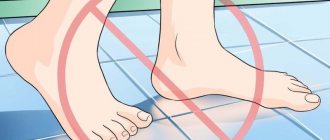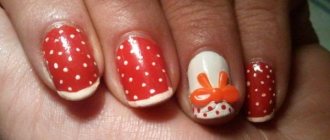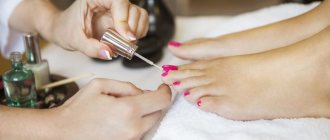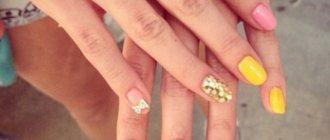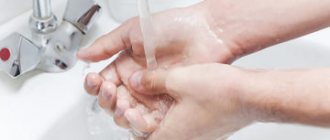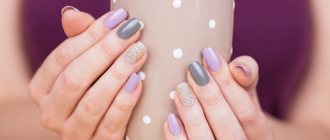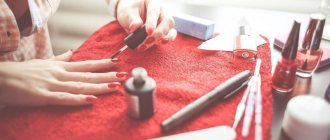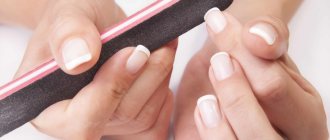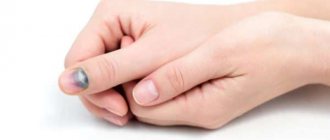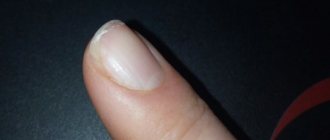Why can gel polish be dangerous for nails?
Gel coating is often the cause of deteriorated nail plates. Perhaps wearing the polish for too long has caused your nails to get used to the coating. Yellowness and brittleness of nails can also appear due to continuous wearing of shellac.
Gel polish is practically no different from shellac. Shellac is the same gel coating, only patented by the manufacturer. Therefore, if your master assures that wearing shellac cannot harm your nails in any way, remember that this is not so.
What to do if your nails peel under gel polish
If the coating lasted only 1-2 weeks, then this is not always an incredible achievement of the master. Often, the wearing time of the coating depends on the quality of the nail plate. After all, if it is tender and soft, no base will stick to the nails. However, it is worth highlighting other reasons why nails may peel. So, the main reasons include:
- Thin, tender and weak nails.
As already mentioned, on weak nails the coating will either adhere poorly or not at all. The solution in this situation may be conventional extension.
- Wet, damp hands.
In fact, some nail plates have excess moisture, and in this situation a single treatment of the nails with a dehydrator may not be enough. Many masters process the nail plate several times, and this, in turn, allows the masters to dry and prepare the nails for coating.
- Errors in preparing the nail plate.
READ ALSO: Fashion life hacks for plus-size women
The problem is that, often, masters file down the nail plate too much, instead of sawing in one direction.
In what cases is it not recommended to wear gel polish?
You just cured nail fungus
- A medicated coating is perfect for you, but not a permanent manicure using gel polish. The varnish can cause damage to the nail plate, which was cured of fungus just a few days ago. If you don’t want the situation to repeat itself, limit yourself to regular or special varnishes.
- There are several types of medicated nail polishes. For example, a strengthening coating will create an invisible film on the nail plates, on which you can apply regular colored varnish. The coating, designed to combat yellowness, has a large number of healing elements. It can help if even vitamin complexes cannot cope with the problem.
- After treatment for fungus, your doctor should advise measures to take to prevent recurrence. Usually this includes giving up gel polish for a while. However, you can do the manicure yourself. The European unedged method is suitable - it is the least traumatic. There are no mechanical actions on the part of special manicure tools or apparatus, the cuticle is not damaged - the nails can be renewed day by day despite the presence of a therapeutic coating.
One of the nails was ingrown
- And when you had to remove it. In most cases, the procedure for removing an ingrown nail involves cutting off only the edge of the entire plate and applying sutures to prevent relapses. If the ingrown toenail was on your toenail (such problems are very rare on the hands), you will have to use a nail extension procedure to restore its appearance.
- Do not extend your nails immediately after surgery. Firstly, for about a week after removing the nail and removing the stitches from your finger, you should not have a pedicure (or manicure). Secondly, let the seam heal: do not try to remove the cuticle in any way yourself or from a specialist. And only after two to three weeks you will be able to go for a pedicure or manicure again. At the same time, a therapeutic coating (which can also be strengthening) is mandatory!
Nails are very peeling
- If you apply gel polish to peeling nails, they simply won’t last long. The coating will come off the nail plate within a few days after application (even if strengthened with acrylic powder). Therefore, you will need to undergo a course of nail treatment and only then do a coated manicure again.
Why can’t gel polish be applied to peeling nails?
The scales of the plate will slowly move away from each other just under the coating. If it is medicinal, the nail will be sealed, but a regular strengthening gel will not help improve the situation. Therefore, do not risk the health of your nails and read materials on how you can quickly and painlessly give your nails a healthy look, and then heal them from the inside.
In this situation, vitamin complexes with calcium, vitamins E and B5 will help. If we talk about medicinal products, use special varnishes that need to be applied closer to the cuticle, and oils that care for the skin at the base of the nail. They will help improve your nails.
Nails are too brittle
Thin nail plates tend to break. Therefore, instead of once again asking the master to strengthen your nails, fill microcracks with acrylic composition and cover the plates with colored shellac, ask about the benefits of a therapeutic coating in your situation. A competent manicure and pedicure specialist will be able to advise the most suitable healing product, which will most likely be in the master’s arsenal.
If your master cannot find the best remedy to solve your problem, refer to our material, in which we described in detail the best means to eliminate nail problems.
Nails covered with white spots
- The most striking signal of problems in the body is white spots appearing on the nail plates. A deficiency of certain vitamins and calcium can also manifest itself in a similar form. If you find small white spots on your nails, start taking special vitamin complexes and do not use gel polish.
- A good treatment option may be a coating that cannot be removed from the nails. A similar varnish is applied to the nail plates and fixed close to the cuticle. Then you don’t need to try to remove or file it off - the transparent varnish will grow back along with the nail, and the grown edge can be carefully filed down every few days. During the time until the nails are completely renewed, the varnish will have time to act on the plates and saturate them with useful elements.
There are cracks in the nails
- Which can appear both under gel polish and under regular coating without strengthening. The cracks go deep into the nail and do not end at just one grown edge. In this case, you will need strong strengthening of the nail plates - and not shellac on top of a nearly broken nail.
The strengthener must be therapeutic - otherwise it simply will not act on the root of the problem.
- If you want to make an acrylic reinforcement, abandon this idea in favor of a more natural and easily removable coating. Acrylic strengthening is performed on top of the applied transparent gel polish, so this method of solving the problem of cracks on nails is not suitable for us.
Nails cannot “wear” gel polish for a long time
This is a direct consequence of constantly wearing shellac without a break. If you haven't given your nails the proper amount of time to rest, constantly go for manicures or pedicures with gel polish and don't use regular polishes, at some point the plates may simply get tired. In order to revive their ability to wear gel polish for a month and a half, you will need to take a break between manicure or pedicure sessions.
Such a break can last about a month. In any case, it will not be harmful to you - your nails without coating will become healthier, and you will be able to remove the cuticle on your own at least every week. In such a case, manicures and pedicures can be done - it is only important not to overload your nails with excessive layers of gel polish.
Nails extended for medical reasons
If you had to extend your nail on the recommendation of your doctor, it is best to leave this plate uncoated. Limit yourself to strengthening varnish, which can be removed with ordinary liquid without acetone. Or ask for a Japanese manicure and rub the manicure paste into your cuticles to polish your nails and give your hands a more well-groomed look.
Don’t worry - any experienced nail technician can grow a piece of nail the same color as the whole plate. Especially considering the fact that extension pastes come in different colors (even pink).
Be careful about the health of your nails and do not wear gel polish if it is contraindicated for you!
And on our website you can always find interesting materials with step-by-step techniques for safe manicure, advice from experienced industry professionals, and even video tutorials.
Reasons why shellac does not adhere well and chips at the tips of the nails
If the coating is applied correctly, in compliance with all requirements and the sequence of steps, shellac should last for at least two weeks - without peeling, chipping or other defects.
But sometimes the coating becomes unusable much earlier than the guaranteed period.
Why this happens, let's look at the possible reasons.
Mechanical damage
Oddly enough, women often forget that they have, in fact, glass on their nails, polymerized and frozen, but still fragile.
It cannot withstand significant mechanical loads.
The most common mechanical damage includes damage caused by active typing on the keyboard, or by accidental impact on a table or other hard surface. In addition, sometimes the nail can be damaged by a car door or even a refrigerator. Therefore, all manicurists strongly recommend being as careful as possible with this coating. Of course, don’t reach the point of fanaticism, but don’t forget that shellac is fragile on your nails. You can find out about Chanel mascara here.
If you have a habit of impatiently drumming your nails on the table, get rid of it quickly. If you often do this with shellac-coated nails, then no master will guarantee that the manicure will last two weeks. Most likely, much earlier the shellac will be covered with miniature cracks, and then it will slowly begin to chip.
Violation of technology
This reason happens when the manicurist did not fully study all the intricacies of applying shellac, or was careless, forgot to degrease the plate, or missed some of the stages of the three-phase system.
In the case of one of these reasons, the shellac will begin to move away from the plate quite soon; perhaps within a couple of days you will notice the first detachments at the cuticle.
Exposure to chemicals
Some types of shellac are resistant to aggressive household detergents containing solvents, bleaches, and bleach.
Therefore, be careful when working with such compounds and wear gloves. In addition, in addition to shellac, this will also protect the delicate skin of your hands.
Nail condition
Many manicurists even refuse to apply shellac or dissuade the client from the procedure when they see that her nails are thin and too soft, with a layered structure.
On such nails, the coating usually does not last long. You can find out about L'Oreal Color Riche Mono shadows by following the link.
Poor quality materials
Sometimes a manicurist buys materials at a discount, or at sales, and may end up with a product that has expired or a low-quality counterfeit of an expensive brand.
As a result, it is not surprising that after a procedure carried out using such products, the coating refuses to adhere.
Hormonal surges
Shellac can fall off the nails for purely internal reasons of the client. Hormonal activity during pregnancy, taking OCs, medications for diabetes and other diseases can lead to material detachments.
Taking antibiotics can also negatively affect the condition of shellac nails, so be sure to keep this in mind.
The natural nail seems to reject the artificial coating, despite observing all stages of application and precautions.
Therefore, masters usually warn the client about a possible risk, explaining to her what could happen.
So that there is no “surprise” later when, a couple of days after the procedure, the coating begins to gently slide off the nails.
On video: why shellac doesn’t stick well on nails
We invite you to read in our article what shellac nails are.
Add folk recipes for strengthening your hair to your piggy bank here.
Look at the color palette of hair dye Concept
Mistakes of poor application on the nail, as the reason why shellac peels off and cracks
What mistakes when applying shellac can cause the material to peel off?
Poor preparation of the plate before the procedure. The preparation stage must be given no less attention than the actual application of the product. In particular, an incompletely removed pterygium can cause the gel polish on the nails to crack. The pterygium is the thin skin at the base of the nail. It can be removed only by high-quality treatment with a nail file or a special attachment on a manicure machine. The last way is the best.
Sometimes the artist forgets or does not consider it necessary to use a special primer before applying the base layer. And, indeed, many types of shellac exclude this stage.
However, experienced craftsmen say that even if the primer is not included in the procedure for applying this type of shellac, it is advisable to use it.
This product perfectly dries the plate, removes excess fat, dust and microscopic fluff that the degreaser could not cope with. Therefore, when applying a primer, the likelihood of shellac durability is much greater.
Degreasing the surface of the nails must be done with a special liquid, and not with nail polish remover or acetone. This can also affect the final result.
You cannot use regular cotton pads when applying shellac. In order to degrease the nail, you need special lint-free wipes or a sterile bandage.
These materials do not have lint, and a cotton pad will leave a bunch of hard-to-remove lint on the surface of the plate.
Do not forget that any speck can lead to detachments and material removal.
Poor drying can affect the final result. According to the rules, it is recommended to dry your nails for two minutes at each stage. Most UV lamps even have a special timer designed for exactly this time. However, sometimes drying occurs too quickly when the master or client is in a hurry, or, conversely, the nails are “overexposed” in the lamp. As a result, after some time, detachments can be observed.
Often, when applying shellac, such a simple but mandatory technique as sealing the end of the nail is forgotten.
Keep in mind that the end is sealed only with transparent materials: base and finish.
Colored gel polish is simply applied to the plate from above without smearing the edges. Sealing is necessary because it blocks access to air, liquids and, accordingly, microorganisms, to the space between the layers of material.
If the sealing is done well, nails with shellac will last a long time, and you don’t have to worry about contact with water.
Applying too thick layers of base, finish or color may result in them not drying completely in the lamp. The result is detachments.
Inaccurate application of shellac leads to it getting on the cuticle. In this case, the likelihood of early detachments is almost guaranteed. And for a complete look, you should pay attention not only to your nails, but also to your eyelashes, so your best choice would be to use Max Factor Masterpiece mascara or Pupa mascara.
In the video about errors in application and the reasons for the short wearing time of shellac
Tips to prevent shellac from chipping and coming off the nail plate
Some useful tips and tricks to help you avoid problems with shellac.
Pay special attention to preparing the nail plate before the procedure.
The natural nail must be thoroughly polished, degreased, and a primer must be applied to it.
If you skip or perform poorly one of these preparation stages, then material detachments are almost inevitable.
If your nails are thin and brittle, it is recommended that you first treat them before trying shellac.
Take a course of special vitamins with calcium, buy medicinal varnish, make paraffin baths for your hands at home.
Once the plate has hardened, you can begin the procedure with greater confidence, knowing that the coating will last a long time.
If you want to make shellac at home yourself, choose professional products rather than the popular “3 in 1”. Although the latter are cheaper, they do not guarantee quality results. But the three-phase system, tested by time and hundreds of masters, will cope with any nails much better and with higher quality. This also applies to mascara; you should choose a high-quality one, for example, L'Oreal Telescopic.
Try to purchase products from the same brand. This method will greatly reduce the risk of possible detachments. Products of the same brand are already suitable for each other, so using them is logical and profitable.
There is no need to shake bottles of products before applying shellac. Such shaking can lead to the appearance of air bubbles in the liquid, which is undesirable.
Be careful when applying shellac. There is no need to touch your nails while working, apply hand cream, oil - all this will lead to the appearance of greasy stains, which means that the next layer of material will no longer have high-quality adhesion (adhesion) to the surface.
Don't forget to check that the lamps in the UV device are working properly. If even one lamp out of four does not work, this may result in the coating not drying completely.
After the procedure is completed, it is not recommended to wet your nails for two hours. During this time, the shellac will finally polymerize. And then you can safely take water procedures without fear that water will get between the layers of coating.
If you have your nails done by a specialist, then wait for the correction, and do not start to shorten or file your shellac-coated nails yourself.
This in most cases leads to detachments and even sometimes to complete “sliding” of the material.
When planning to visit a salon, choose a good specialist. In this case, it is best to use the old proven method - word of mouth. Friends and work colleagues may well suggest and recommend their master, who is an excellent applicator of shellac. A recommendation from a good friend is the best guarantee of quality work.
After applying shellac, try to avoid contact with aggressive detergents. Avoid contact with chlorine-containing bleaches and solvents.
If such work cannot be avoided, wear gloves. You can find out about lipsticks from Pupa in this article.
